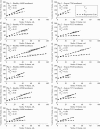Minimally invasive estimation of ventricular dead space volume through use of Frank-Starling curves
- PMID: 28448528
- PMCID: PMC5407648
- DOI: 10.1371/journal.pone.0176302
Minimally invasive estimation of ventricular dead space volume through use of Frank-Starling curves
Abstract
This paper develops a means of more easily and less invasively estimating ventricular dead space volume (Vd), an important, but difficult to measure physiological parameter. Vd represents a subject and condition dependent portion of measured ventricular volume that is not actively participating in ventricular function. It is employed in models based on the time varying elastance concept, which see widespread use in haemodynamic studies, and may have direct diagnostic use. The proposed method involves linear extrapolation of a Frank-Starling curve (stroke volume vs end-diastolic volume) and its end-systolic equivalent (stroke volume vs end-systolic volume), developed across normal clinical procedures such as recruitment manoeuvres, to their point of intersection with the y-axis (where stroke volume is 0) to determine Vd. To demonstrate the broad applicability of the method, it was validated across a cohort of six sedated and anaesthetised male Pietrain pigs, encompassing a variety of cardiac states from healthy baseline behaviour to circulatory failure due to septic shock induced by endotoxin infusion. Linear extrapolation of the curves was supported by strong linear correlation coefficients of R = 0.78 and R = 0.80 average for pre- and post- endotoxin infusion respectively, as well as good agreement between the two linearly extrapolated y-intercepts (Vd) for each subject (no more than 7.8% variation). Method validity was further supported by the physiologically reasonable Vd values produced, equivalent to 44.3-53.1% and 49.3-82.6% of baseline end-systolic volume before and after endotoxin infusion respectively. This method has the potential to allow Vd to be estimated without a particularly demanding, specialised protocol in an experimental environment. Further, due to the common use of both mechanical ventilation and recruitment manoeuvres in intensive care, this method, subject to the availability of multi-beat echocardiography, has the potential to allow for estimation of Vd in a clinical environment.
Conflict of interest statement
Figures



References
-
- Sagawa K. Editorial: the end-systolic pressure-volume relation of the ventricle: definition, modifications and clinical use. Circulation. 1981;63(6). - PubMed
-
- Suga H, Sagawa K, Shoukas AA. Load independence of the instantaneous pressure-volume ratio of the canine left ventricle and effects of epinephrine and heart rate on the ratio. Circ Res. 1973;32(3):314–22. - PubMed
-
- Suga H, Sagawa K. Instantaneous pressure-volume relationships and their ratio in the excised, supported canine left ventricle. Circ Res. 1974;35(1):117–26. - PubMed
-
- Stevenson D, Revie J, Chase JG, Hann CE, Shaw GM, Lambermont B, et al. Beat-to-beat estimation of the continuous left and right cardiac elastance from metrics commonly available in clinical settings. Biomed Eng Online. 2012;11:73 doi: 10.1186/1475-925X-11-73 - DOI - PMC - PubMed
MeSH terms
LinkOut - more resources
Full Text Sources
Other Literature Sources
Medical

